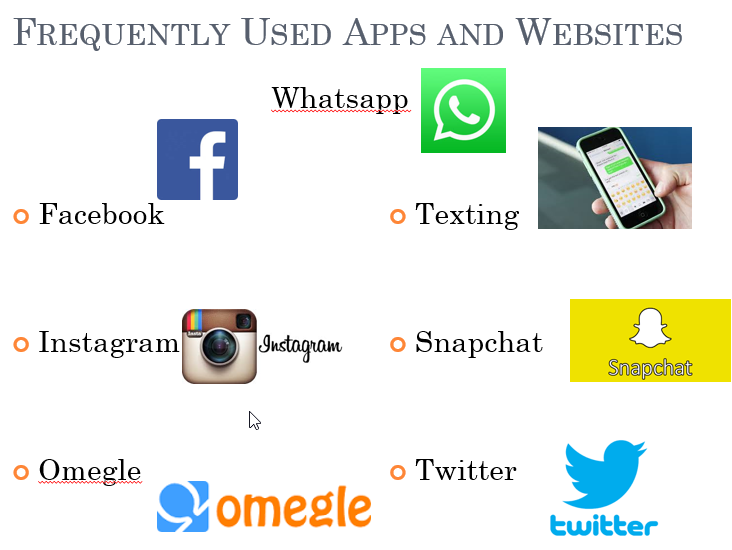Internet safety and youth

“Sex, Drugs ‘n Facebook,” the facetious title of a 2013 book by educator and public health researcher Megan A. Moreno, is described as a “smart parent’s guide to raising cybersensible kids.” The book discusses risks – (links to depression, for example) and benefits (access more information than you could ever dream of) present in the digital world of today’s young people. These days, it’s probably apps like Snapchat and Instagram rather than Facebook that take up the bulk of many young people’s online time, proof that one of the challenges for adults helping young people navigate cyberspace is keeping up with the rapidly changing nature of the beast. Many parents would love it if technology could help them with this decidedly 21st century parenting issue, but most experts agree that what’s called for is garden-variety communication: as in talking. With that in mind, here are some tips:
A digital footprint can harm
We’ve all heard stories about impulsively posted comments or pictures that lead to unintended consequences. You may recall an incident in which Harvard University rescinded the admission of 10 students who posted or shared offensive memes on Facebook. Worst-case scenarios like that do occur, even if they are relatively rare when you consider how much time young people spent online. Parents and caregivers need to help sometimes-impulsive young people understand that what they post on social media can bring embarrassment, regret and heartache if they do it without careful thought. They need to be reminded that potential employers, coaches and college admissions teams do indeed review applicant’s social media presence.
Tact and cyberbullying
Many teenagers do much of their socializing with peers via text and other social media. It is, therefore, important for adults to engage young people in conversations about their online behavior. Among the pitfalls are negative interactions with others that can range from minor pettiness to outright bullying. Education is the aim. Remind them that texting and social network posts don’t have the benefit of visual cues like facial expressions and body language and that without these social cues, their texts and posts can easily be misread. Misunderstood posts can hurt others and those hurts will complicate their school lives as well.
In cases of bullying, teens should seek help from a parent or other trusted adult. When teens approach grownups about bullying, they should never ignore or minimize. Meanwhile, teachers and school administrators need to realize that even if bullying begins online and away from school property, it usually also shows up in school. State law mandates that schools respond promptly and effectively to in-school bullying. The Massachusetts Anti-Bullying Act (M.G.L. c. 71, sec. 37O), also requires that schools address cyberbullying that occurs off school premises if it creates a hostile environment at school for the targeted student, infringes on or her rights at school, disrupts the education process or otherwise interferes with the orderly operation of a school.

Online Predators
Some adults may know that strangers they interact with online might not actually be who they present themselves to be, but tweens and even some teens may find this hard to believe. Moreno’s book suggests parents talk to children about boundaries and communication within the context of their social media habits. She and other experts suggest adults discuss with young people why boundaries are important both in person and online, and that parents figure out where they stand on issues like monitoring children’s internet exploration through privacy settings and the like. Families differ on these matters, so there’s not a specific recommendation. Moreno suggests that the early-childhood stranger danger warnings parents give to their children have a place in their early years on their digital path. If tweens and teens develop on-line friendships with people they’ve never met in person, parents should tell them they must meet them at your home for the first in-person meeting.
Sexting
Local focus groups conducted by the Northwestern District Attorney’s office confirmed what national studies reveal, that teenagers are sending sexually suggestive and sometimes explicit images via text much more often than many adults think. Experts say sexting has become a stage of courting, another element in developing romantic relationships. Local teens also reflected national studies that suggest the reasons for sexting include: approval and validation; to gain confidence and get attention; for sexual exploration and intimacy; and in some cases because they feel pressured to do it.
There are no specific sexting laws in Massachusetts, but sending sexually explicit images of minors violates child pornography laws even if the image is of the person sending it, and in situations where they have OK’d it. Consent by a minor is not a valid defense to child pornography charges. While there are many cases of consensual sexting between minors that are not criminally prosecuted, there are many other highly problematic issues at stake: the possibility that images can be forwarded or distributed; once images are in circulation they can be extremely difficult to remove from circulation; and instances where teens feel pressured into sending an image. Young people might need guidance to figure out how to say no gracefully. Research suggests what’s most helpful is discussing with young people ideas around internet and cell phone safety, romantic relationships, healthy boundaries as well as refusal strategies. Not helpful, experts say, are ultimatums, scare tactics, blaming the victim and gender stereotyping.

Time and screens
Parents worry most about Internet problems related to others, whether it be strangers or troublesome flare-ups with friends or school mates. But there’s an equally concerning trend among young people: the sheer amount of time spent on their phones. Researcher Jean M. Twenge, author of “Have Smartphones Destroyed a Generation?” in the September, 2017, issue of The Atlantic magazine, contends that increased time on smartphones correlates to increased rates of teen depression and suicide and reports of social isolation.
“The arrival of the smartphone has radically changed every aspect of teenagers’ lives, from the nature of their social interactions to their mental health. These changes have affected young people in every corner of the nation and in every type of household. The trends appear among teens poor and rich; of every ethnic background; in cities, suburbs, and small towns. Where there are cell towers, there are teens living their lives on their smartphone,” she writes.
Twenge notes that a well-respected national survey of teens reveals that those who spend more time than average on screen activities are more likely to be unhappy, and those who spend more time than average on nonscreen activities are more likely to be happy.
“There’s not a single exception,” she says. “All screen activities are linked to less happiness, and all nonscreen activities are linked to more happiness.”
That revelation bears as much consideration and thought as do concerns about privacy settings, social media etiquette and the potential for interaction with online predators. Most parents will agree they want their children to live healthy and happy lives. Thinking about what gets in the way of that is well worth their time.
Here are some resources parents, caregivers and educators may find helpful in thinking about how to help young people navigate what can be confusing terrain around social media, screen time and Internet safety.
Common Sense Media, nonprofit working to educate parents, youth, policy-makers on media and technology issues:
Netsmartz, National Center for Missing and Exploited Children offers interactive resources and tips for parents and educators. Deals with Internet safety, sexting, phones. Programs geared to children ages 5-17.
Online Sense, educates parents, teachers, students, schools on Internet Safety; offers activities, online classes, other resources.
100 Conversations, offers conversation starters and other resources for parents around sex, sexting and cyber-safety.
That’s Not Cool, resources for students to learn about abusive dating relationships, particularly digital dating abuse; also talks about how adults can help.
Media Smarts, Canadian center for digital/media literacy, tips on sexting and other issues like managing screen time and more.
"The Social Dilemma," a Netflix documentary, raises issues parents, caregivers and educators might want to consider. A link to trailer here. For more information, visit the Center for Humane Technology website.
And while it is unlikely that technology is the solution to the problems that can crop up when young people become active on social media, there are sites or links that offer various apps for managing and monitoring screen time. Below are links to a few:
A feature on iPhones that allows parents to monitor their children’s (and their own) iPhone use and then decide whether to set limits.
This app automatically tracks iPhone and iPad use daily. Can set daily limits and be notified when you go over. Can force yourself off your device when you’re over your limit.
An app that monitors family iPhone and iPad use; sets aside time for entire family to be screen-free using family dinner time. Enforces limits when any family member is using device too much.
An App that gives students rewards for not using phones while at school. Points award student discounts, coupons, gifts.
Parental control app that can block sites and monitor time and use.
This app allows parents to manage time their kids spend on smart phones and other devices.
This link helps parents set limit on time; allows parents to block certain games.
A link that helps sets limits/ block use at bedtime or homework time
This app allows parents to control cell use while teens driving

